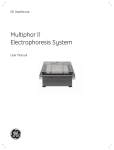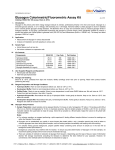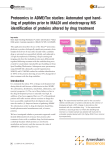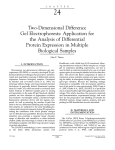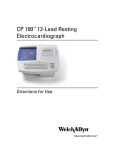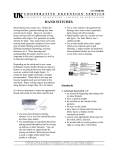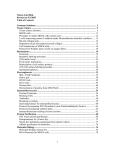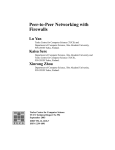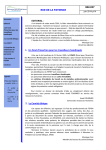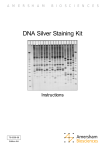Download Immobiline DryPlate - GE Healthcare Life Sciences
Transcript
instructions Immobiline DryPlate User Manual i 71-7030-01 Edition AD Important user information Reading this entire manual is recommended for full understanding of the use of this product. The exclamation mark within an equilateral triangle is intended to alert the user to the presence of important operating and maintenance instructions in the literature accompanying the instrument. Should you have any comments on this manual, we will be pleased to receive them at: Amersham Biosciences AB S-751 82 Uppsala Sweden Amersham Biosciences AB reserves the right to make changes in the specifications without prior notice. Warranty and Liability Amersham Biosciences AB guarantees that the product delivered has been thoroughly tested to ensure that it meets its published specifications. The warranty included in the conditions of delivery is valid only if the • p2 product has been installed and used according to the instructions supplied by Amersham Biosciences AB. Amersham Biosciences AB shall in no event be liable for incidental or consequential damages, including without limitation, lost profits, loss of income, loss of business opportunities, loss of use and other related exposures, however caused, arising from the faulty and incorrect use of the product. Trademarks Immobiline, Multiphor, MultiTemp, PlusOne, NovaBlot, Sephadex and NAP are the exclusive trade marks of Amersham Biosciences AB. In view of the risk of trade mark degeneration, it is respectfully suggested that authors wishing to use these designations refer to their trade mark status at least once in each article. Copyright© 1995 Amersham Biosciences AB All rights reserved. No part of this publication may be reproduced, stored in a retrieval system or transmitted in any form or by any means, without permission in written form from the company. Reading this entire manual is recommended for full understanding of the use of this product. Contents 1. Introduction ....................................................................... 5 1.1 Package contents and technical data ......................... 6 2. Preparing the gel .............................................................. 7 2.1 Preparing the rehydration solution .............................. 7 2.2 Opening the package ................................................. 8 2.3 Rehydrating Immobiline DryPlate ................................ 9 3. Sample treatment ............................................................. 10 3.1 Sample preparation ................................................... 10 3.2 Sample concentration ................................................ 10 4. Isoelectric focusing .......................................................... 11 4.1 Preparing the experiment .......................................... 11 4.2 Sample application .................................................... 11 4.3 Running conditions .................................................... 12 5. Detection .......................................................................... 14 5.1 Silver staining ............................................................. 14 5.2 Coomassie staining .................................................... 17 5.3 Electrophoretic transfer ............................................. 18 6. Evaluation ......................................................................... 19 6.1 Determination of the isoelectric point ......................... 19 6.2 Densitometric evaluation ............................................ 19 7. References ...................................................................... 20 8. Ordering information ......................................................... 22 • p3 • p4 1. Introduction Immobiline™ DryPlate offers a convenient and reliable way to obtain the utmost separation power of isoelectric focusing. The Immobline system has indefinitely stable pH gradients allowing high voltages for maximal separation and, when necessary, long focusing times (1, 2). The rehydratable dry gels facilitate the use of additives such as urea, detergents, carrier ampholytes etc, for optimal performance, even for samples with poor solubility. This manual gives general instructions on how to use Immobiline DryPlate for isoelectric focusing. Please consult the Application Notes and/or the articles in the reference list (3–21) for detailed instructions on specific applications. Immobiline DryPlate is a polyacrylamide gel with an immobilized pH gradient. It is bound to plastic backing and is ready to use for isoelectric focusing after rehydration. The product is available with various pH gradients (See Table 1.) The pH gradients are linear over the stated interval. Table 1 Code No. pH interval Major application Appl.Note 80-1128-28 80-1128-29 80-1128-30 80-1128-31 80-1128-32 4–7 4.2–4.9 4.5–5.4 5.0–6.0 5.6–6.6 General purpose α1-antitrypsin Group specific component Transferrin Phosphoglucomutase — 470 471 472 473 • p5 1.1. Package contents and technical data Package contents Each gel package contains 3 gels, filter papers, experimental result forms and instructions. Designation Code No. Immobiline DryPlate Filter paper Experimental result form Instructions (See label) 71-7030-01 No. per pack. 3 50 3 1 Technical data Gel dimensions: Gel matrix: Buffering capacity: Gel backing: Storage: Shelf life: • p6 Approx. 250×110 x 0.5 mm Polyacrylamide T=4%, C=3% 3 meqv/pH/L Polyester film –20° C 18 months from manufacturing. Please observe “Expiry date” printed on each kit. 2. Preparing the gel 2.1. Preparing the rehydra-tion solution One of the advantages of the dry gel format is the opportunity to include different additives in the reswelling solution (10, 14–16, 18–19). The three options given in Table 2 should therefore only be regarded as typical examples that will give good results for most applications. However, whenever required these recipes can easily be modified for further optimization. Consult the relevant Application Note (Table 1 and Reference list) or any of the cited references for instructions about specific applications. The rehydration process itself has also been investigated (20, 21). Table 2. Application areas: Alt.1 Alt.2 Alt.3 Water soluble proteins Proteins with reduced solubility Proteins with low solubility, e. g. Membrane proteins Lipoproteins 20.0 ml 19.5 ml 12.0 ml 0.5 ml Composition: Distilled water Pharmalyte 3–10/ Ampholine pH 3.5–9.5 Urea Triton X-100 DTT Total volume: 20.0 ml 20.0 ml 0.5 ml 9.6 g 0.1 ml 60 mg 20.0 ml Rehydration time: 1–2 h 1–2 h 15–18 h Comments Note: All chemicals should be of the highest purity. PlusOne chemicals are highly recommended. Double-distilled water should be used. The presence of carrier ampholytes not only increases protein solubility but also their electrophoretic migration velocity resulting in shorter focusing times. • p7 Mercaptoethanol (2%) or dithiothreitol (15–50 mmol/l) can be added to avoid oxidation of sensitive proteins. Glycerol (20–25%) improves solubility of hydrophobic proteins and reduces the risk for urea crystallization. Lateral band spreading can be reduced by adding acetic acid (2 mmol/l) and applying the sample at the anodic side or adding Tris (2 mmol/l) and applying the sample at the cathodic side. Triton X-100 can be replaced with other non-ionic or zwitterionic detergents, e.g. CHAPS. Other carrier ampholytes than Pharmalyte 3–10/Ampholine pH 3.5–9.5 may also be used. Alt. 3 in table 2 corresponds to what is used in the first dimension focusing in 2-D electrophoresis. This alternative can be regarded as a standard choice for focusing under denaturing conditions and will normally give high quality results with all kind of samples. 2.2. Opening the package Note 1: Wear clean gloves to avoid contamination of the gel surface, particularly when using silver stain. Note 2: The gel is packed so that it is faced down to the aluminium foil backing of the package, and the gel support is uppermost. Note 3: If only half of the gel is to be used, cut the package in half with sharp scissors, reseal the portion to be saved with tape, and store it at –20°C. Remember to identify the polarity of the remaining part. Open the gel package from the transparent side. Use scissors to cut around all four sides of the package, taking care not to cut either the gel or its transparent backing film. To simplify gel handling later on, identify the polarity of the pH gradient. The support film has a precut corner which indicates the anodic side of the pH gradient. • p8 2.3. Rehydrating Immobiline DryPlate For this procedure the specially designed Reswelling Cassette is highly recommended. It allows fast, convenient, even and reproducible rehydration of the gel. It also facilitates including the additives necessary for optimal performance for each application. Proceed as follows: (See the instruction manual for the Reswelling Cassette or the Multiphor II Electrophoresis System user manual for detailed instructions). 1. To prevent the gel from adhering to the glass plate fitted with the U-frame, coat the plate with Repel-Silane. 2. Mark the cathodic side of the gel. 3. Wet a clean thick glass plate with a few drops of water and place the gel on the glass plate with the gel side up. 4. Roll the gel with a clean rubber roller (Code No. 80-1106-79) to remove all air bubbles from between the glass plate and the support film. 5. Mount the gel in the cassette taking particular care that the U-frame gasket seals also over the cut-off corner of the supporting plastic foil and that the clamps are mounted correctly to avoid leakage. 6. Fill the cassette with the desired rehydrating solution. 7. Leave the gel to rehydrate for the recommended time. 8. Open the cassette and check the gel surface. Remove excess liquid by placing a filter paper moistened in distilled water on top of the gel followed by a dry filter paper on top. 9. Blot the gel by gently rolling the rubber roller under slight pressure over the dry filter paper. Finally remove the filter papers carefully from the gel. (Since gels rehydrated in detergent containing solutions have less tendency to stick to dry filter paper, they can be dried with a simpler procedure: Place a piece of dry tissue paper (e.g. Kleenex) on the gel, press gently to ensure contact between tissue and gel, and remove the paper carefully.) • p9 3. Sample treatment 3.1 Sample preparation Even if Immobiline DryPlate is exceptionally tolerant towards impure samples, best results are still obtained with samples that are free from precipitates. Should aggregation occur at the application point, this can often be overcome by diluting the sample or changing the sample application position. Best results are generally obtained when the samples are solubilized in the rehydration solution. If this is not possible, the concentration of salt and buffer ions should still be kept at a minimum and, as a general rule, preferrably below 50 mmol/l. Excess buffer and salt ions will cause local overheating due to high local currents, which can result in protein denaturation and/or prolonged running times. Desalting and buffer exchange can be carried out by dialysis, or, more easily, by gel filtration using a prepacked Sephadex G-25 column (Choose NAP-5 Column, NAP-10 Column or PD-10 Column depending on the sample size. See Ordering information). 3.2. Sample concen-tration In general, Immobiline gels can take much higher sample loads than corresponding gels with carrier ampholytes. Several factors will determine the optimal sample concentration and volume: 1. pH range 2. Number and relative proportions of the components in the sample 3. Sensitivity of the detection method used. Guide lines: PhastGel™ Blue R stain detects proteins down to the µg range. Normally 15–20 µl of sample with a concentration of 0.5–10 mg/ml will give good results. Silver staining has about 20 times higher sensitivity. A suitable load in a narrow pH gradient is normally 2–3 times higher than the load in a pH 4–7 gradient. • p10 4. Isoelectric focusing 4.1. Preparing the experiment Setting the cooling temperature Connect Multiphor II electrophoresis unit to MultiTemp II thermostatic circulator and set the desired running temperature. A running temperature of 10 °C is often used except for gels containing urea, which are preferably run at somewhat higher temperatures (15 °C or more) to avoid precipitation of the urea. Switch on the thermostatic circulator 15 minutes before starting the run. Positioning the gel on the cooling plate Pipette a few milliliters of insulating fluid (kerosene or light paraffin oil) on the cooling plate of Multiphor II. Position the gel on the cooling plate so that the polarity of the gel corresponds with the polarity marked on the cooling plate. Ensure that no air bubbles are trapped between the gel and the cooling plate. Electrode strips are used to ensure good electrical contact between the gel and the electrodes. This prevents sparking and allows salt ions from the gel to migrate into the electode strips where they will stay and not interfere with the separation. Soak the electrode strips evenly with approximately 3 ml distilled water and remove the excess by using a filter paper. The electrode strips should appear very dry before they are applied to the gel. Lay the electrode strips along the long edges of the gel. Cut off the parts of the strips which protrude beyond the short ends of the gels using a pair of sharp scissors. 4.2. Sample application There are basically three different methods for sample application. Which method to choose is determined primarily by the sample volume. • p11 1. For 5–20 µl sample volumes: Apply sample directly on the gel, using Immobiline applicator strip (Code No. 18-100276). This applicator strip makes it possible to use a multiple syringe which allows quick and simple sample loading, especially when working with large numbers of samples. Check that the contact between the gel and the applicator strip is uniform. Leave the applicator strip on the gel during focusing. 2. For 15–20 µl (and larger) sample volumes: Use sample application pieces (Code No. 80-1129-46). Apply the dry pieces to the gel surface at the desired position(s) in the gradient. Using a micropipette, apply 15–20 µl volumes of sample solution on each piece. To apply larger volumes, use 2 or 3 pieces stacked or laid end-to end. If you want to apply smaller volumes with by this method, trim the paper proportionally before applying it to the gel. Remove the pieces of paper after completing half the total focusing time. 3. For 2–10 µl sample volumes: Apply the sample as droplets directly on the gel surface. 4.3. Running conditions Place the electrode holder on the Multiphor II electrophoresis unit and align the electrodes with the center of the electrode strips. Finally, connect the two electrodes to the base unit and place the safety lid in position. Connect the electrode leads to the power supply. Typical running conditions are listed in Table 3. Table 3. pH range Voltage (V) 4–7 4.2–4.9 4.5–5.4 5.0–6.0 5.6–6.6 3 500 3 500 3 500 3 500 3 500 • p12 Current(mA) 5.0 5.0 5.0 5.0 5.0 (1.0)* (2.0) (2.0) (1.0) (1.0) Power (W) Time (KVh) 15.0 15.0 15.0 15.0 15.0 7–15 15–25 15–25 15–25 15–25 Time (h) 2–4 4–7 4–7 4–7 4–7 Comments: – Decrease the power and current settings proportionally if only part of the plate is being used. – The settings above are only to be regarded as guidelines. Some proteins focus very slowly and may require as much as 50–60 KVh to give optimal sharp bands. This must be determined experimentally in each case: Run the sample for different times. – Since there is no gradient drift in the Immobiline DryPlate there is no limitation in the electrophoresis system as such as to how long the experiment can be continued. The limits are set only by the risk of drying out the gel, oxidising or denaturing the sample. These risks can be minimized by placing a plastic foil on top of the gel, running at low tempera-tures, flushing the unit with inert gas (N2) and/or including a reducing agent (DTT or b-mercapto-ethanol) in the rehydration mixture. The surface can also be protected with DryStrip Cover Fluid (22). • p13 5. Detection All currently used detection methods can be applied on Immobiline DryPlate gels, including Coomassie Blue (4, 14), silver staining (23). Possible problems from extensive swelling of the gel can be reduced by adding ethanol (30%) to the washing solutions. Enzymatic- and immunologically-based staining procedures as well as blotting can also be used (10–12). 5.1 Silver Staining This silver staining method is according to Heukeshoven and Dernick (23) with some modifications. Silver staining solutions Note: 250 ml of solutions are needed per gel. All steps should be done with gentle shaking of the tray. • p14 Fixing solution: 60 min Trichloroacetic acid Ethanol Dissolve in distilled water and make up to 250 ml. 30.0 g 125 ml Wash: 2 × 15 min Ethanol Acetic acid Make up to 500 ml with distilled water 150 ml 50 ml Incubation solution: minimum 40 min Ethanol Sodiumacetate • 3 H2O Glutardialdehyde (25%w/v)* Sodium thiosulfate, Na2S2O3 • 5 H2O Make up to 250 ml with distilled water 75 ml 17.0 g 1.3 ml 0.50 g Wash: 3 × 5 min Distilled water Silver solution: 20 min Silver nitrate Formaldehyde* Make up to 250 ml with distilled water 0.25 g 50 µl Developing solution: Sodium carbonate 5–15 min Ethanol Formaldehyde* Make up to 250 ml with distilled water 6.25 g 75 ml 25 µl Stop solution: 10 min EDTA-Na2 • 2 H2O Ethanol Make up to 250 ml with distilled water 3.0 g 75 ml Wash: 5 min Ethanol Make up to 500 ml with distilled water 150 ml Preserving solution: 20 min Glycerol (87% (w/w) Ethanol Make up to 250 ml with distilled water 25 ml 75 ml * Note: Add these components immediately before use. • p15 Fixation Remove the electrode strips by using forceps, thereafter immediately immerse the gel in the fixing solution for 60 minutes. This solution precipitates the proteins and allow detergents (if used) to diffuse out. Washing Thereafter wash the gel in washing solution for 2 × 15 minutes. Incubation Place the gel in incubation solution for a minimum of 40 minutes. The gel can be left over night in the incubation solution. Washing Thereafter, wash three times in distilled water, each time for 5 minutes. Silver reaction Put the gel in silver solution for 20 minutes. Developing Develop the gel in developing solution for 5–15 minutes. The protein bands should become intensively dark. Stopping Stop the reaction by placing the gel in stop solution for 10 minutes. Washing Wash in washing solution for 5 minutes. Preserving To preserve the silver stained gel, place the gel in preserving solution for 20 minutes. Then place the gel on a glass plate with the gelside up, and cover the gel with cellophane preserving sheet soaked in preserving solution. Allow the gel to dry in room temperature (Do not put the gel in a heating cabinett, the silver stain will bleach due to the increased temperature). • p16 5.2 Coomassie staining This is a general protein stain which detects protein concentrations down to the µg level. 250 ml of solution is used in each step. Fixing solution: 30–60 min Destaining solution: 5 min Coomassie solution: 10 min Trichloroacetic acid Sulphosalicylic acid Make up to 400 ml with distilled water 46 g 14 g 1. Ethanol Make up to 1000 ml with distilled water 2. Acetic acid Make up to 1000 ml with distilled water Mix 1:1 before use 500 ml PhastGel™ Blue R Dissolve 1 tablet in 400 ml destaining solution. Stir with a magnetic stirrer and heat the solution to 60 °C. Filter before use. Use only once. 160 ml 1 tablet See above Destaining solution: Until the background is clear Preserving solution: Glycerol Add 360 ml destaining solution and mix well. 40 ml Fixation Remove the elexctrode strips with forceps. Immediately place DryPlate in Staining Kit containing fixing solution for 30–60 minutes. This solution precipitates the proteins. • p17 Destaining Before staining, wash DryPlate in destaining solution for 5 minutes. Staining Pour off the destaining solution and stain DryPlate for 10 minutes in staining solution which has been preheated to 60 °C. Destaining Destain DryPlate with several changes of destaining solution until the background is clear. Preserving Place the destained DryPlate in the glycerol preserving solution for 30–60 minutes. Then place the gel on a glass plate with the gel side up, and cover the gel with a cellophane preserving sheet soaked in preserving solution. Allow it to dry at room temperature. 5.3 Electro-phoretic transfer Before electrophoretic blotting can take place, the support film must be removed to allow the current to pass through the gel. FilmRemover is ideal for this purpose. After the film and the gel have been separated, the proteins can be transferred to an immobilizing membrane by using the Multiphor II NovaBlot transfer kit. Complete information on running conditions is given in Multiphor II User Manual (Code No. 18-1103-43). • p18 6. Evaluation 6.1 Determination of the isoelectric point Because of the low ionic strength in the gel, the pH gradient cannot be directly measured with a standard surface pH electrode unless carrier ampholytes have been included in the rehydrating solution (21). An alternative to direct pH measurement is to run pI calibration proteins in parallel with the experimental samples. For details about the use of pI calibration proteins see the Instruction enclosed with each pI Calibration Kit. 6.2 Densitometric evaluation ImageMaster 1D Software (Code No. 80-6350-37) is a powerful software package for protein quantitation and data analysis. By using ImageMaster 1D Software together with ImageScanner (Code No. 18-1134-45), you can capture, store, evaluate, and report all the information contained in your electrophoresis gels. ImageMaster 1D Software automatically selects your lanes, bands, subtracts the background, corrects the smiling, and integrates areas and band volume (OD × mm2). The software calculates relative amounts, percentages of totals, and amounts of proteins in real quantity units using a calibration curve. ImageMaster 1D Software also calculates isoelectric points or molecular weights, compares bands across different lanes or gels, and produces hierarchial clustering information. Further lane comparision, databasing, and identification using an internal library can be done by using ImageaMaster 1D Database (Code No 80-6350-94) and an add-on package to ImageMaster 1D Software. • p19 7. References 1. Isoelectric focusing in immobilized pH gradients. Principle, methodology and some applications. J. Biochem. Biophys. Meth. 6 (1981) 317–339, Bjellqvist B., Ek, K., Righetti, P.G., et al. 2. Righetti, P. G.. Immobilized pH gradients: Theory and Methodology. Vol. 20, Laboratory techniques in Biochemistry & Molecular Biology. Elsevier, 1990. 3. Analysis of alpha1-Antitrypsin phenotypes in Immobiline electrofocusing gels. Application Note 470, Amersham Biosciences AB. 4. Analysis of Gc phenotypes by IEF in Immobiline gels. Application Note 471, Amersham Biosciences AB. 5. Analysis of the Transferrin phenotypes in Immobiline electrofocusing gels. Application Note 472, Amersham Biosciences AB. 6. Analysis of Phosphoglucomutase (PGM1) phenotypes in Immobiline isoelectric focusing gels. Application Note 473, Amersham Biosciences AB. 7. Subtyping of group specific component (Gc) in human semen, blood and vaginal fluid by isoelectric focusing in immobilized pH gradients. Electrophoresis 9 (1988) 602–605, Pötsch-Schneider, L. and Klein, H. 8. Carbohydrate analysis of transferrin subfractions isolated by preparative isoelectric focusing in immobilized pH gradients. Electrophoresis 4 (1992) 225–229, G. de Jong, W. L. van Noort and H. G. van Eijk. 9. Isoelectric focusing of apolipoproteins on immobilized pH gradients: Improved determination of apolipoprotein E phenotypes. Electrophoresis 9 (1988) 576–579, Baumstark, M. W., Berg, A., Halle, M. and Keul, J. 10. Microheterogeneity of apolipoprotein D as revealed by electroblotting following isoelectric focusing in Immobiline DryPlates. Electrophoresis 4 (1992) 262–264, Holmquist, L. 11. Phenotyping of Apolipoprotein-E. Immunoblotting After Isoelectric Focussing in Immobilized pH Gradients Electrophoresis 12 (1991) 59–63, Marz, W., Cezanne, S. and Gros, W. 12. Immobilized pH gradient isoelectric focusing and immunoblotting for investigations of anti-Borrelia burgdorferi IgG antibodies. Electrophoresis 4 (1992) 229–234, M. Cruz and Å. Sidén. • p20 13. Isoelectric focusing in Immobilized pH Gradients – applications in Clinical Chemistry and Forensic Analysis (review). J. Chromatogr. 569 (1991) 197–228, Righetti, P. G., Gianazza, E., Bianchibosisio, A., et al. 14. The application and optimisation of solubilising additives in Immobiline gels. Application Note 345, Amersham Biosciences AB. 15. Membrane protein analysis by isolectric focusing in immobilized pH gradients. Electrophoresis 6 (1985) 419–422, Rimpilainen, M. A. and Righetti, P. G. 16. Hybrid isoelectric focusing in rehydrated immobilized pH gradients with added carrier ampholytes: Demonstration of human globulins. Electrophoresis 6 (1985) 314–325, Altland, K. and Rossman, U. 17. Analysis of recombinant proteins by isoelectric focusing in immobilized pH gradients. Electrophoresis 4 (1992) 214–220,R. Bischoff, D. Roecklin and C. Roitsch. 18. Apolipoprotein E phenotyping by isoelectric focusing in immobilized pH gradients and silver staining. Electrophoresis 4 (1992) 252–258, R. Cartier and A. Sassolas. 19. Rapid and simple method for the identification of apolipoprotein E isomorphic phenotypes from whole serum. Electrophoresis 4 (1992) 258–262, M. Kohlmeier, H.-J. Drossel, P. Sinha and E. Köttgen. 20. Swelling kinetics of Immobiline gels for isoelectric focusing. Electrophoresis 5 (1984) 257–262, Gelfi, C and Righetti, P. G. 21. Improved rehydration procedure for polyacrylamide gels in presence of urea: Demonstration of inhereted presence of prealbumin variants by isoelectric focusing in an immobilized pH gradient. Electrophoresis 5 (1984) 379–381, Altland, K., Bantzhoff, A., Hackler, R. and Rossman, U. 22. Immobiline™ DryStrip Kit Instructions (Code No. 18-1038-63). 23. Simplified method for silver staining of proteins in polyacrylamide gels and the mechanism of silver staining. Electrophoresis 6, (1985) 103–112, Heukeshoven, J. and Dernick, R. 24. pH measurements in ultranarrow immobilized pH gradients. J. Biol. Biophys. Meth. (1986) 113–124, Gelfi, C., Morelli, A., Rovida, E., and Righetti, P. G. • p21 8. Ordering information Code No. Designation 80-1128-28 80-1128-29 80-1128-30 80-1128-31 80-1128-32 Immobiline Immobiline Immobiline Immobiline Immobiline 80-1106-79 18-1004-40 18-1002-76 80-1129-46 Roller IEF electrode strips (100) Immobiline applicator strip (5) IEF sample application pieces (200) DryPlate pH 4–7 DryPlate pH 4.2–4.9 DryPlate pH 4.5–5.4 DryPlate pH 5.0–6.0 DryPlate pH 5.6–6.6 17-0851-01 PD-10 column, Desalting samples <= 2.5 ml (30) 17-0853-01/02 NAP-5 column, Desalting samples <= 0.5 ml (20/50) 17-0854-01/02 NAP-10 column, Desalting samples <= 1.0 ml (20/50) 18-1018-06 18-1130-05 18-1102-77 18-1102-78 18-1016-86 18-1013-75 80-1129-38 80-6350-37 18-1134-45 17-0518-01 17-0471-01 17-0472-01 17-0473-01 • p22 Multiphor II electrophoresis unit EPS 3500 XL Power Supply MultiTemp III Thermostatic Circulator, 115 V AC MultiTemp III Thermostatic Circulator, 220 V AC NovaBlot electrophoretic transfer kit FilmRemover Cellophane preserving sheets, 210×320 mm (50) ImageMaster 1D Software ImageScanner PhastGel Blue R Broad pI Calibration kit, pH 3–10 Low pI Calibration kit, pH 2.5–6.5 High pI Calibration kit, pH 5–10.5 Code No. Designation PlusOne chemicals 17-1319-01 Urea 17-1315-01 Triton X-100 17-1325-01 Glycerol 87% (w/w) 17-1317-01 2-Mercaptoethanol 17-1318-01 Dithiothreitol (DTT) • p23 Important Information Immobiline, Multiphor, MultiTemp, PlusOne, NovaBlot, Sephadex and NAP are trademarks of Amersham Biosciences Limited. Amersham and Amersham Biosciences are trademarks of Amersham plc. © Amersham Biosciences AB 2002 – All rights reserved All goods and services are sold subject to the terms and conditions of sale of the company within the Amersham Biosciences group that supplies them. A copy of these terms and conditions is available on request. Amersham Biosciences AB Björkgatan 30 SE-751 84 Uppsala Sweden Amersham Biosciences UK Limited Amersham Biosciences Corporation 800 Centennial Avenue P.O. Box 1327 Piscataway, NJ 08855 USA Amersham Biosciences Europe GmbH Munzinger Strasse 9 D-79021 Freiburg Germany Amersham Biosciences K.K. Sanken Building, 3-25-1 Shinjuku-ku, Tokyo 169-0073 Japan Produced by Wikströms, Sweden 1021704, 12.2002 Printed matter. Licence 341 051 Amersham Place, Little Chalfont Buckinghamshire, England HP7 9NA

























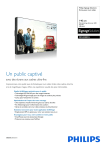


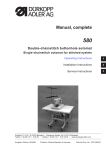
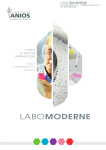


![Nutrition dans l`espace_Espace Explorat[...] - dubel](http://vs1.manualzilla.com/store/data/006394729_1-25072548e357e668aee2caa2d25cad9f-150x150.png)
